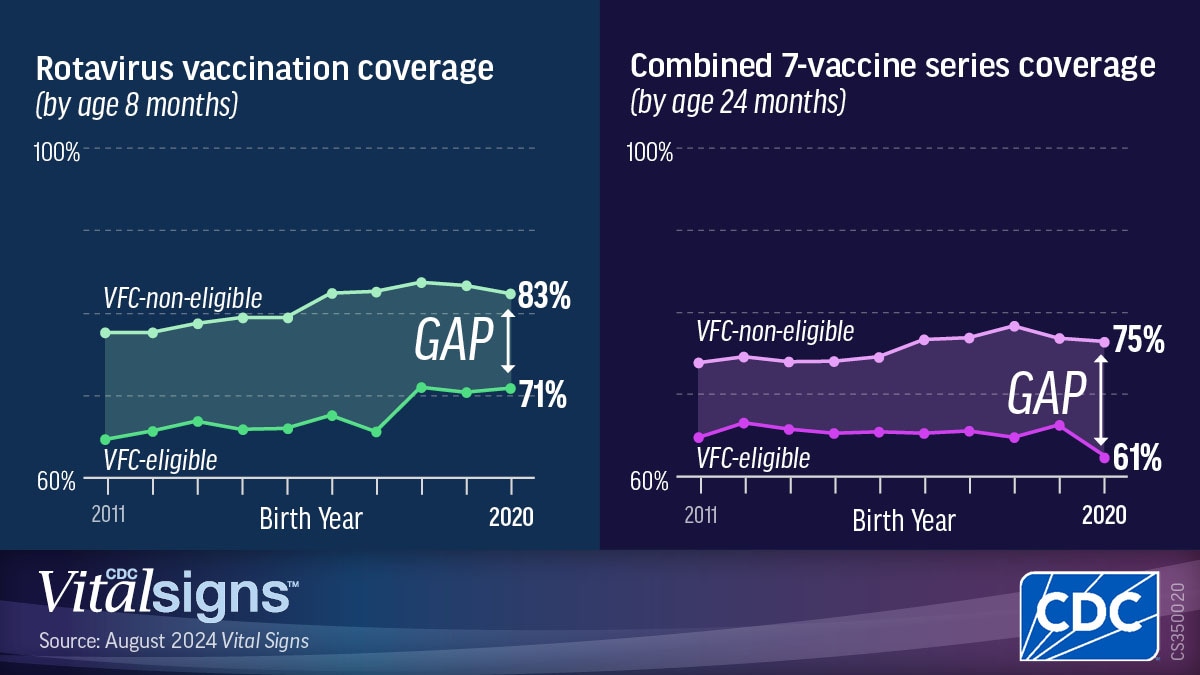Statement
Despite historic successes, gaps remain for children living below the poverty level and those without health insurance.

When the Vaccines for Children (VFC) legislation was passed 30 years ago, it was a historic step in improving children's lives by providing recommended vaccines at no cost to eligible children.
Routine vaccinations are the best defense against illnesses. The VFC program was established to ensure that children below the federal poverty level and those without health insurance have access to critical, lifesaving vaccines that can protect their health throughout their lives.
“For 30 years, the Vaccines for Children program has been providing lifesaving vaccines to our nation’s children at no cost,” said CDC Chief Medical Officer Dr. Deb Houry. “Because of congressional support and dedicated partners across the country, we have prevented more than 1.1 million deaths in kids born during the VFC era. There is no better time than now, as families are planning for returning to school, to continue this effort that keeps our children safe from disease and prepares them for the fall and winter virus season.”
Almost 90% of VFC-eligible children born during 2011–2020 received the measles, mumps, and rubella (MMR) vaccine, according to a new CDC Vital Signs report. There were no differences in receipt of the MMR vaccine found among VFC-eligible children born in 2020 by race and ethnicity, poverty status, and urban-rural residency. This highlights VFC program efforts in achieving and maintaining measles elimination status in the U.S.
In addition, the new CDC Vital Signs report shows routine childhood rotavirus vaccination increased from 65% to 71% among children born in 2011–2020, which shows progress toward achieving high vaccination coverage (proportion of children vaccinated) for all routine immunizations.
Furthermore, a CDC report, issued on August 8, 2024, found that for children born during 1994–2023, routine childhood vaccinations will have prevented approximately 508 million cases of illness, 32 million hospitalizations, and 1,129,000 deaths, resulting in societal savings of nearly $2.7 trillion, including a direct savings of $540 billion.
Despite these successes, the new CDC Vital Signs report shows there is still a need to increase the number of children who complete their vaccine series and a need to reach children living below the poverty level and those without health insurance.
- Only 61% of VFC-eligible children (born in 2020) received 7 selected vaccines (the "combined 7-vaccine series") by their second birthday. This series includes all recommended doses of diphtheria and tetanus toxoids and acellular pertussis (DTaP) vaccine, poliovirus vaccine, measles-containing vaccine, Haemophilus influenzae type b conjugate vaccine (Hib), hepatitis B vaccine, varicella vaccine, and pneumococcal conjugate vaccine (PCV). Of these vaccines, coverage among VFC-eligible children born in 2020 was about 90% for first doses of vaccines (varicella, MMR) and for series given earlier in life (poliovirus, hepatitis B vaccine).
- Vaccination coverage was lowest (74%-77%) for vaccines that require multiple doses, with at least one dose recommended after 12 months of age (DTaP, PCV, and Hib). This suggests children face challenges to receiving vaccines that require multiple doses as well as doses in the second year of life.
- Vaccination coverage was lower among uninsured children than among Medicaid-insured children. Uninsured children are more likely to live at or below the federal poverty level and have not seen a healthcare provider in the past year. They are less likely to complete vaccine series that require multiple doses.
- VFC-eligible children living below the federal poverty level had lower coverage for rotavirus vaccine and the combined 7-vaccine series compared with VFC-eligible children living at or above the poverty level. Although the VFC program provides recommended childhood vaccines at no cost, non-Medicaid VFC-eligible children, including those who are uninsured, can be charged a vaccine administration fee, and there may also be fees for an office visit or non-vaccine services received during the visit.

Healthcare providers can help reduce missed opportunities for vaccination by giving catch-up vaccinations to all children who are behind. The VFC program plays a vital role in increasing and sustaining vaccination coverage for all vaccinations, including flu and COVID-19 vaccinations. Heightened efforts must ensure those eligible for the VFC program are aware of, have confidence in, and are able to receive all recommended vaccines.
Healthcare providers can:
- Offer accurate information on vaccination benefits.
- Give catch-up vaccines and review for needed vaccines, including those that protect children in the fall virus season that includes flu and other respiratory viruses.
- Strengthen relationships with families.
- Use reminder/recall systems to inform parents of upcoming or missed shots.
The Vaccines for Children program is administered nationally by CDC, which provides operational funding to 61 state, local, and territorial immunization programs. Funding recipients implement and oversee the VFC program in their respective areas. The federal government purchases pediatric vaccines at a discount and ships them directly to enrolled VFC vaccine providers to ease the fiscal burden of vaccine purchase and distribution. The VFC program ensures that all children have a better chance of getting their recommended vaccinations on schedule which means healthier children, families, and communities.
For more information on VFC eligibility for children, go to Vaccines for Children (VFC) Program: Information for Parents | VFC Program | CDC.
If you are a healthcare provider interested in enrolling in the VFC program to help ensure all families can get the vaccines they need, please visit Vaccines For Children (VFC) Program Information for Providers | CDC.
For more information about this report, go to www.cdc.gov/vitalsigns.
